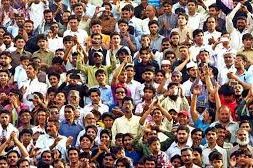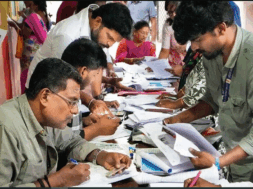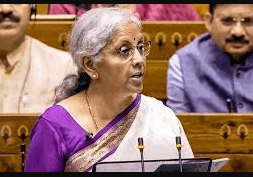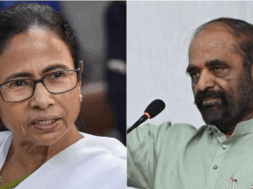
Manas Dasgupta
NEW DELHI, Apr 19: India has overtaken China to become the world’s most populous country with an estimated population of 142.86 crores, according to the data released by the United Nations Fund for Population Activities (UNFPA) on Wednesday. China with a population of 142.57 crores has been relegated to the second position, the UN report said.
This is the first time that India has topped the UN list of most populous countries since it started collecting population data in 1950.
In 1990, the population of China was 1144 million (1.144 billion) compared to India’s 861 million. Last year, China remained the most populous country in the world with 1426 million people, with India just behind with 1412 million. The UN’s 2022 projections said by 2050, India’s population will reach 1668 million, far exceeding China’s, which would have declined to 1317 million.
India outstripping China has been no surprise and has been anticipated for some time now. But what has expedited the process is the fact that China’s growth has been slowing. Earlier this year, the National Bureau of Statistics (NBS) in China reported it had 850,000 fewer people in 2022 than the previous year.”
China is facing a looming demographic decline as birth rates plunge and its workforce ages. Several regions have also announced plans to boost birth rates — but official efforts have so far failed to reverse the decline.
India has no recent official data on how many people it has because it has not conducted a census since 2011. India’s once in a decade census was due to be held in 2021 but was delayed due to the coronavirus pandemic.
The UN data also showed that nearly 25 per cent of India’s population is under the age of 14, while 68 per cent of the population is in the 15 to 64 years age group and about seven per cent above the age of 65.
Estimates by different agencies have suggested that India’s population is expected to keep rising for nearly three decades before it peaks at 165 crore and then would start declining. The new UN report also estimated that the global population would hit 8.045 billion by mid-2023.
Other countries, mostly in Europe and Asia, can expect a demographic slump over the coming decades, according to other UN figures published last July which forecast how the world’s population will develop between now and 2100.
One of the most important aspects of the story of India’s population growth is also the inbuilt opportunity of a “demographic dividend”. The new UNFPA report says that more than two-thirds of India’s population (68 per cent) comprises people between the ages of 15 and 64, which is considered the working population of a country. As per Census 2011, the population of young people (10-24 years) in India was 365 million, which the 2022 UN World Population Report projected would increase to 379 million in 2023.
But while India is experiencing an increase in absolute numbers, due to lower fertility rates, the proportion of young people in the population is likely to decrease in the coming years. The proportion of the young population in India was more than 30 per cent in the 2011 Census, which is expected to reduce to 26.5 per cent as per UN World Population Projection, 2022.
“We will of course not know the exact numbers till the next Census is carried out. This lack of data is an issue. What is significant is that India is in a unique position in which the young population and working population are larger than that of the population which needs care — that is the children and the elderly, unlike countries such as Japan which have a declining population and an increasing elderly population. Such countries are and will be in dire need of skilled labour, and this is something that India can provide, capitalising on our demographic dividend,” Poonam Muttreja, Executive Director of Population Foundation of India said.
However, “For this education, skilling, and providing job opportunities are a dire need,” she added. “India signed a MoU with Japan earlier this year by which Japan will invest in skilling — similar MoUs with other countries is a beneficial option for India, by which our workforce can be used in other countries.” A country like South Korea, which has the lowest fertility rate in the world, for example, beat its own record and reported a birth rate of 0.78, down from 0.81 in the previous year, Muttreja pointed out.
“A study carried out in 2004 showed that the skilling in India was two per cent of the population which rose to four per cent in 2006. If India wants to capitalise on its demographic dividend, this gap needs to be bridged,’’ she said.
Neeraj Ahuja, who leads the mass rural entrepreneurship programme for Transform Rural India (TRI), an organisation that works with several Union ministries including those of Rural Development and Youth Affairs, said with basic schooling and access to the Internet the rural youth are now more aspirational than ever.
“The rural youth now want dignified job opportunities, but the fact is that such opportunities are lacking. The urban youth have a significant advantage with job opportunities available to them. We carried out a study in the district of Ramgarh in Jharkhand in 2020 which has a total population of 12 lakh and a population of 3.5 lakh between the ages of 15-30 years. We found that 2.5 lakh youths were either educated and unemployed or underemployed,” Ahuja said.
“This is a problem because when the youth have opportunities, they can propel a country’s economy, but when not, they can create social problems,” he said, adding that a large youth population is now positioned to join the job market.
TRI is now working on a district-level entrepreneurship model. “Each district has its own specific conditions and aspirations. What works for Pune or Mumbai may not work for Ramgarh. So, the government needs to look at creating district-specific opportunities,’’ Ahuja said.
Social demographer Sonal Desai said there has been a focus in India on the service sector, which has definitely been beneficial for the country. “But with such a large population at hand, I would recommend that the government looks at more labour-intensive industries as well and would like to see India focusing on manufacturing more so that job opportunities are created for the youth,” Desai said.
According to Desai, the government should focus on skilling two sections of the population — the youth and women. “Women want to work but they don’t have the spaces created for them to do so. For instance, when NREGA was introduced, we suddenly saw large numbers of women working under the scheme simply because they finally had the opportunity,” she said.
Desai pointed out that the migrant worker population also needed to be managed and monitored. “Ageing in South India, for instance, is far higher than in the North. We are already seeing a large number of workers migrate from Odisha or Bihar to Kerala and Tamil Nadu. This migration is expected to increase. Migration is inevitable. But what we need to do is to make migration easier — to not restrict to men migrating, but even women and children. We need to put in place a system of conveniences, such as easy access to school for migrant children, or small or temporary housing for these families,” she said.














